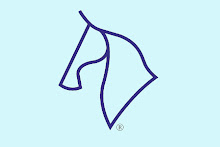Visit www.soloequestrian.com to read about Solo Harness, the loading innovation
Pain or the memory of pain can influence ridden behaviour HUGELY. The most common sources of pain in the ridden horse are from the teeth, from the tack and from the feet.
Teeth
Horse teeth wear away as they grind huge amounts of forage, and so they have to continuously 'grow' from the jaw throughout the horses life. Virtually all riding horses have a top jaw that is wider than their bottom jaw which means that they don't wear evenly - sharp edges tend to appear on the outside of the top teeth and the inside of the bottom teeth. Problems with teeth often manifest as avoidance of the bit - opening the mouth, twisting the head. The bridle can compound tooth pain, especially if a tight noseband is used as this squashes the cheeks and tongue onto the sharp teeth. The pain from the teeth can also interfere with eating. The solution is to have your horses teeth checked once or twice per year by a qualified equine dentist or a horse vet.
Tack
Check that your bridle fits comfortably, especially the browband. Many horses seem to be squeezed into a browband thats too small and squashes their ears - not comfortable. The bit is also important, with some horses being far more comfortable in a bitless bridle. The saddle, however, is more often the cause of poor performance. I'm not going to go into it here, but check out http://www.balanceinternational.com/ and http://www.enlightenedequitation.com/index.html for really useful info on saddles and saddle fitting.
Feet
Correct foot balance is vital for your horses comfort. A shod horse should be checked every six weeks by the farrier to avoid hoof growth unbalancing the limbs. A barefoot horse is less likely to suffer problems with foot balance as some wear to the foot will be happening, but barefeet should still be checked regularly. One check you can do yourself is to look at the hoof/pastern axis - looking from the side, the front line of the hoof should be parallel to the line that runs through the middle of the long and short pasterns. The most common fault is that the foot will slope more than the pastern line - this is known as 'broken-back' and puts lots of strain on the back part of the hoof and in particular the navicular bone. Memory of pain If a horse has suffered pain or discomfort in the past, it won't necessarily realise straight away that the pain has gone. Time and patience will often be needed to let the horse realise that it is comfortable, for instance if the horse has been ridden for a while in an uncomfortable saddle, its way of going will have become adapted to avoiding as much discomfort as possible and it may take some skillful handling to persuade the horse to try going in a more 'normal' way.
For further reading on these issues, try
'No Foot No Horse' by Gail Williams and Martin Deacon
'For the Good of the Horse' by Mary Wanlass
Visit www.soloequestrian.com to read about Solo Harness, the loading innovation
Subscribe to:
Post Comments (Atom)

No comments:
Post a Comment